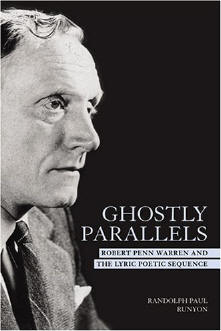
"Runyon has an incredibly sharp eye for detail,
repeatedly bringing to bear startling connections in Warren's
middle-period poems which nobody but he could have noticed but which
instantly strike even readers predisposed to be skeptical as completely
plausible." John Burt,
Editor of
The Collected Poems of Robert Penn Warren
"Runyon's argument
rests on two main pillars: a remarkably astute eye for tracing the
patterns that give continuity and coherence to Warren's verse, and a
broad-ranging command of relevant scholarship, both about other critics
of Warren and about Warren's allusions to myth, history, religion, and
similar literary resources....The resulting overview of Warren's poetic
achievement is both incisive and comprehensive." Victor Strandberg,
Author of The Poetic Vision of Robert Penn
Warren |
GHOSTLY
PARALLELS
ROBERT
PENN WARREN AND
THE LYRIC POETIC SEQUENCE
by Randolph Paul Runyon
Cloth
ISBN: 1-57233-465-7
Library of Congress No.: LC 2005035884 Publication Date: 3/15/2006 240
pp.
America's
most eminent man of letters in his later years, and certainly one of the
greatest Southern writers, Robert Penn Warren has increasingly come to
be known for his poetry. Ghostly Parallels is a close examination of the
heart of his poetic corpus-the eight collections published between 1935
and 1976: Thirty-Six Poems; Eleven Poems on the Same Theme; Promises;
You, Emperors, and Others; Tale of Time; Incarnations; Or Else; and Can
I See Arcturus from Where I Stand?
Ghostly Parallels shows how Warren constructed collections of
poems based on common subjects and contexts and also contends that,
while the poems are distinctive, taken together they reveal intricate
patterns of theme, imagery, and diction within explicit sequences.
Runyon demonstrates that Warren's collections are integrated,
well-crafted wholes, and each poem references its predecessor-sometimes
in intriguingly self-referential ways. Runyon shows that despite the
many changes in diction, tone, and subject that Warren underwent in his
long career, his concern for writing his poems in such a way that they
could reach out beyond themselves to other poems remained remarkably
constant. In the arrangement Warren gave them, his poems form “ghostly
parallelst”-an expression that appears in “The Return: An Elegy,” where
they refer to the railroad tracks that bring the poet home to his dying
mother.
This return to the mother is a persistent leitmotif in the poems
and forms the other major theme of this study: Warren's personal poetic
myth, in which such images as golden light and mirror images are signs
of the mother's presence as both Danae, mother of Perseus, and Medusa,
whom Perseus confronted.
Through pursuing sequential patterns as well as echoes and myth,
Ghostly Parallels brings a wealth of insights to the work of this
prolific novelist, critic, and essayist. An important guide for
undergraduate and graduate students alike, Ghostly Parallels will also
appeal to anyone with an interest in Robert Penn Warren and southern
literature. |
